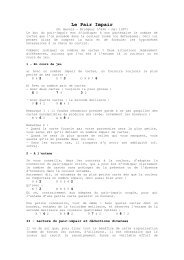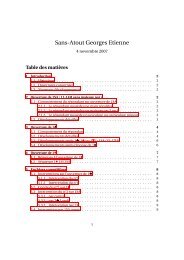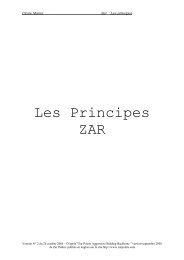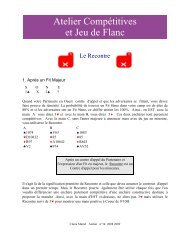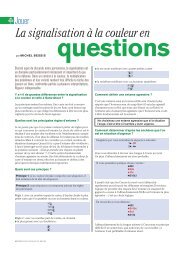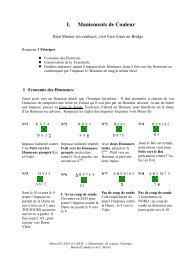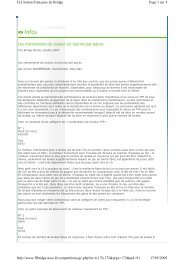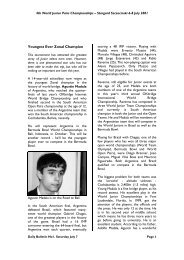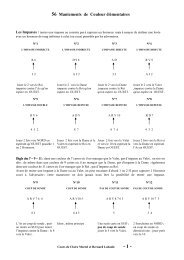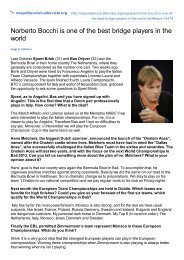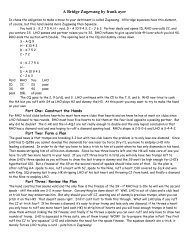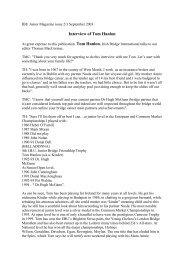Virtual Vacant Spaces - Claire Bridge
Virtual Vacant Spaces - Claire Bridge
Virtual Vacant Spaces - Claire Bridge
You also want an ePaper? Increase the reach of your titles
YUMPU automatically turns print PDFs into web optimized ePapers that Google loves.
additional material from:<br />
<strong>Bridge</strong>, Probability and Information<br />
Bob mackinnon<br />
<strong>Virtual</strong> <strong>Vacant</strong> Places<br />
Kelsey’s Rule shows how the vacant places remaining for two or more suits can<br />
be related to the probability that one defender or the other holds a missing<br />
honor. The rule requires all insignificant cards in a suit be played before their<br />
subtraction from the vacant places can be justified. What if it is not convenient<br />
to reduce a suit to that extent? Then one must employ an inferential count. Such<br />
estimates will be subject to an increased level of uncertainty, but one needn’t<br />
bury one’s head in the sand. So we come to the concept of a virtual vacant place.<br />
If we can associate probabilities with real, discrete vacant places, why can’t we<br />
do the opposite and relate virtual vacant places to probabilities in a continuous<br />
relationship?<br />
Here is how it works. Suppose that a declarer in a spade contract receives the<br />
opening lead of a low diamond. There are six diamonds missing, so the defenders<br />
hold twenty cards between them in the other suits. Say declarer wins the first<br />
trick with the ace in dummy, the RHO following, and decides go about drawing<br />
trumps. Which defender is the more likely to hold the missing trump queen?<br />
That depends on what declarer makes of the opening lead.<br />
Suppose the diamonds are split 5-1, leaving 8 vacant places on the left and<br />
12 on the right. The differential in vacant places is 4. If the remaining spades,<br />
hearts and clubs are shuffled and dealt, the chance of any card ending up on the<br />
right is 12 out of 20, or 60%, regardless of the rank of that card. If the diamonds<br />
are split 4-2, the probability of a card being dealt to the right becomes 55%. The<br />
differential in vacant places is 2.<br />
Usually the diamond lead is from length, either a four-card suit or a five-card<br />
suit, and there are just 2 vacant place differentials possible, but on average the
number of cards in the suit lies between four and five, even though there is the<br />
occasional short-suit lead. This idea gives rise to the concept of a virtual vacant<br />
place differential that represents an average length that can’t exist in reality.<br />
Here are the results for integer differentials:<br />
Real Conditions<br />
Split <strong>Vacant</strong> Places Probability (%) Differential<br />
3 – 3 10 –10 50.0 – 50.0 0<br />
4 – 2 9 – 11 45.0 – 55.0 2<br />
5 – 1 8 – 12 40.0 – 60.0 4<br />
<strong>Virtual</strong> Conditions<br />
Split <strong>Vacant</strong> Places Probability (%) Differential<br />
3.5 – 2.5 9.5 –10.5 47.5 – 52.5 1<br />
4.5 – 1.5 8.5 –11.5 42.5 – 57.5 3<br />
A virtual split involving half cards is not physically possible, but it is possible<br />
when one is dealing with the average length of the suit led. Naturally, declarer<br />
would prefer to gather more evidence relating to the situation that actually exists.<br />
Nonetheless, he can estimate probabilities if he is able to judge the opening<br />
lead with respect to how many cards he expects the opening leader to hold, on<br />
average, in the suit led. In Chapter 8 of <strong>Bridge</strong>, Probability and Information<br />
we further explore the relationship between the opening lead, information and<br />
probability.




